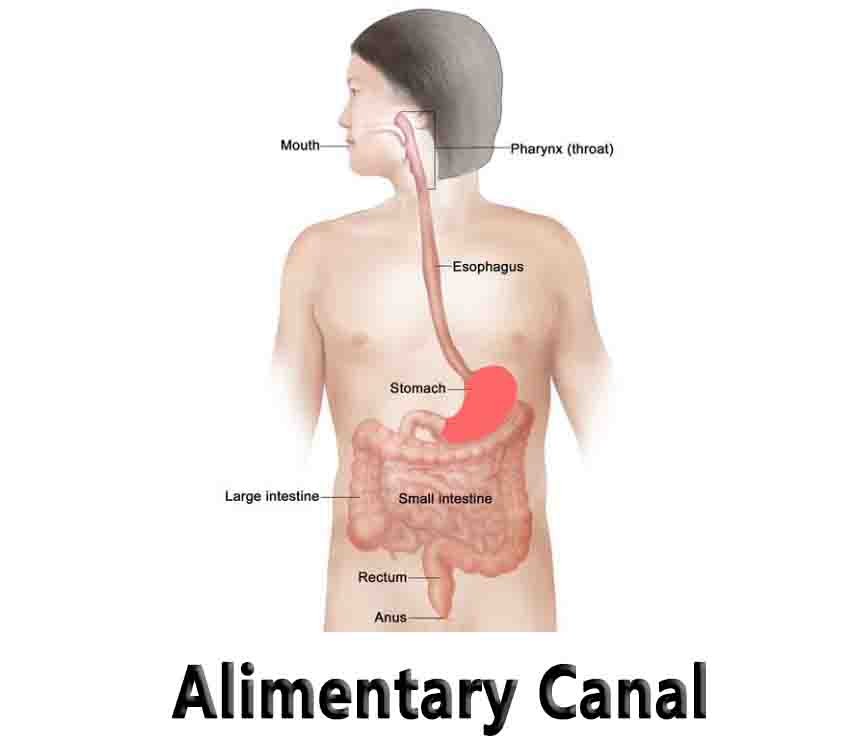Alimentary Canal Definition
The alimentary canal is a continuous passage starting from the mouth and ending at the anus, which carries food through different parts of the digestive system and allows waste to exit the body. The alimentary canal varies widely in organism, but is only seen in organism which are bilaterally symmetrical. Various sections of the alimentary canal contain cells which secrete digestive enzymes, allowing food to be broken down.
Other specialized cells allow for the absorption of materials into the body. In human and other highly complex animals, the alimentary canal is organized into specialized tissues and organs. These organs and tissues were derived from the alimentary canal of our earliest ancestors, which likely consisted of a simple tube connecting the mouth and anus.
Alimentary Canal Organs
The organs present in the alimentary canal vary widely between groups of organisms. Some organisms have no well-defined organs or tissues in their alimentary canal, while other have many unique structures. Starting from the mouth, a membrane lined tube connects the mouth to the esophagus, which is called the pharynx. The pharynx has evolved a number of functions in different animals, from housing the gills to providing a structure for filter feeding. Typically, the alimentary canal then continues through the esophagus, which carries food to the stomach.
Some animals, such as ruminants, have multiple stomachs which carry different enzymes and microbiomes to process different parts of their food. After the stomach, food typically passes into the small intestine, which is responsible for extracting the newly freed nutrients into the body, as well as continuing the breakdown of foods. The configuration and arrangement of the small intestine can vary widely, but it usually ends by dumping its contents into the large intestine.
The large intestine functions within the alimentary canal to remove excess water and any remaining nutrients from the food being processed. By the end of the large intestine, only waste and indigestible material remains, and is excreted as stool. The alimentary canal ends at the anus, where waste is excreted into the environment.
Other groups of animals, such as birds, have an entirely different arrangement of organs in the alimentary canal, and contain structures not seen in humans. For example, birds often have a gizzard, which is a muscular organ used to grind food before it enters the stomach.
Mammals do not need this organ because they have the ability to masticate, or chew their food. Other adaptations to the alimentary canal include glands that secrete digestive substances, toxic fangs and teeth, and specially adapted intestines which help animals digest the food available in their niche.
Alimentary Canal Layers
Within the bilaterally symmetrical animals, there are two groups: the protostomes and the deuterostomes. Both groups develop an alimentary canal with three tissue layers, but through different methods. Both groups develop from a single celled zygote into a sphere of cells known as the blastula.
During embryonic development, parts of the sphere will fold inward, and connect to the other side, forming the alimentary canal. When this happens, the layers of the ectoderm are separated from the endoderm. The ectoderm will become the outer layers of the body, while the endoderm will define the lining of the alimentary canal.
The organs that operate with the alimentary canal, such as digestive glands and organs like the liver, are formed from either the endoderm, or from a third tissue that lies between the entoderm and endoderm, the mesoderm.
Related Biology Terms
- Esophagus – A tube, derived from the endoderm of the embryo, which carries food through the thoracic cavity to the stomach below.
- Intestines – Part of the alimentary canal which extracts nutrients and water from the material inside.
- Pharynx – A special tube which connects the mouth to the esophagus.
- Coelom – A cavity within the body, which helps separate the organs and circulatory systems, but never opens to the external environment.

